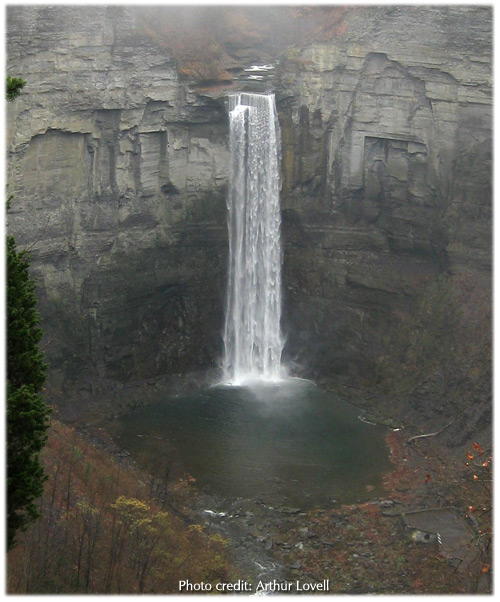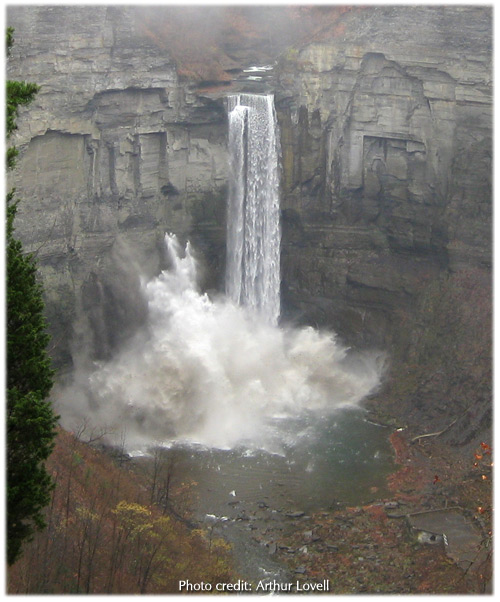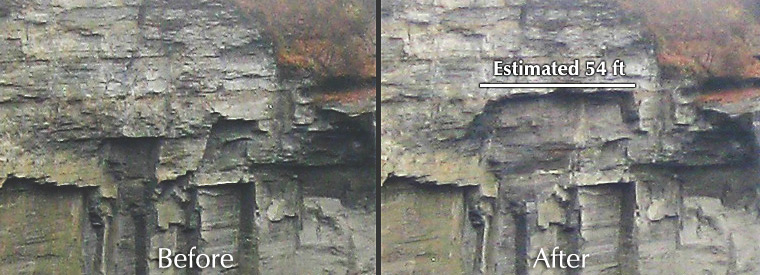Taughannock Falls Rockslide (11/4/2010)


This amazing scene was captured by Arthur Lovell of Oxford, UK, around 2pm on November 4, 2010, when a large section of overhanging sandstone rock from the cathedral-like gorge wall fell into the plunge-pool below, creating a massive wave. The rock is estimated at 54 ft (16.5 m) across, and the void it left can be seen in the before and after below. Taughannock Falls itself is 215 ft (65.5 m) and the surrounding gorge walls extend over 100 ft higher.
Massive rock slides often occur in the Finger Lakes region, which is characterized by relatively soft, and easily-fractured sedimentary rock, but capturing the moment on camera is a rare treat. The danger of rock falls like this cannot be understated. In August of 2005, Deborah A. Rowen, 51, of Westmont, NJ, was killed and three others injured at Taughannock, by a rockslide the size of a small house.
The NY State Office of Parks, Recreation and Historic Preservation’s primary strategy to keep park visitors safe from rock falls, both large and small, is to restrict access to areas at risk. In the case of the 2005 death, the victims had crossed boundaries and wandered off the trail. The state office also sends out scalers, men and women who scale down overhanging cliffs near trails to inspect rock integrity and knock loose potentially dangerous rocks.
Rock falls are the result of natural fractures in the rock (often created by earthquakes, geological shift, swelling, or the natural separation between rock layers) and can be found in virtually all rock layers in the region. Fractures often run perpendicular to each other, forming blocks of rock that can be potentially knocked free. Most are structurally safe. Environmental pressure, erosion and weather can weaken the friction holding blocks of rock. Most frequently, rain saturating porous stone (such as limestone, shale and sandstone) can add the extra weight and lubrication to let gravity pull it free. Ice is another major cause of slides. Rain or melt-water seeps into the fractures and freezes. As the resulting ice expands, it pushes the two rock faces apart. Rock falls are very frequent during times when the temperature rises and dips around the freezing point. Other, less frequent, causes of rock falls can be the extreme drying of rock, which may cause it to shrink enough to set it free. Or plant life can grow within the fractures (such as tree roots) and pry the rocks apart.
The Story
“I was visiting my girlfriend who is at Cornell, we were returning to Ithaca from Buffalo in a rental car just before 2pm on the 4th November, and I persuaded her to stop at the falls overlook. She is less of an outdoors type so she stayed in the car as it was raining, but a friendly guy pulled up in a pickup and told me about a recent landslip that had closed or partly closed the trail in the gorge. We walked down the parking lot away from the falls and eventually got a view down into the gorge where we could see a small [backhoe] parked on a pile of muddy soil which we concluded was the slip. This was before I had even seen the waterfall. While we were there, I thought I heard one or two deep booming noises, a bit like distant blasting at a quarry, over the sound of the rain hissing through trees. I don’t recall exactly how many there were, I didn’t remark on it too much and neither did my companion. We parted ways at the information board, he driving off again, and I went to see the falls.”
“I was taking pictures of the view framed by trees and the stairs down from the overlook, when a large section of the cliff on the left at the level of the top of the falls just dropped away, pretty much as one lump. You can see by comparing before and after shots that it was about 40 by 15 by 6 feet. I reacted just as it hit the pool and took the photo with the splash. The boom this time was huge, like close-range thunder echoing from the cliff-sides, and I am sure I felt the ground shake. I imagined that they would hear it down at the state park offices. At the time I was surprised by how small the wave was, it washed outside the pool but did not threaten the viewing platform down there. I set my camera to video, thinking there was a good chance that more would fall and I would get the whole process in one clip. Unfortunately nothing happened except it began to rain a bit more. About then I realized there was a person crossing the bridge over the creek at the bottom, heading towards the viewing platform, who must have witnessed the fall. I did wonder if it was safe for them to be there. I went back to the car and told my girlfriend what had happened as she was looking a bit nervous but also impatient, as we were already late for an engagement. I said I would be one more minute, went back to look and saw a small piece of rock come down from the same general area and hit the edge of the pool. After that I reluctantly left the scene.”
So there were at least four falls over the 10 minutes I was there, the one I photographed at 2:04 being the biggest (I didn’t see the first falls, I am judging by size of boom).”





